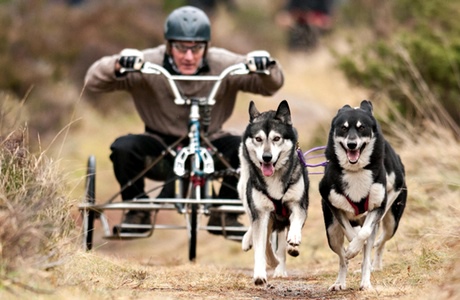
This weekend the town of Aviemore in Scotland will be overrun with thousands of visitors. Most of them, however, are dogs.
The Aviemore Sled Dog Rally, run by the Siberian Husky Club of Great Britain, is the biggest race of its kind in the UK; an unmissable event for British mushers that sees hundreds of teams race through the picturesque Cairngorms countryside.
This year's rally will be the 31st anniversary of the event. It started in 1984 with just 12 teams but is now attended by up to 3,000 onlookers who watch as 200 teams run over 1,000 sled dogs around forest trails beside Loch Morlich.
While sled dog racing is traditionally a sport enjoyed in snow-covered countries, the British sport has been adapted to suit our tepid climate. "In Alaska and Canada the dogs are bred to pull medium loads over long distances and their races can be over 1,000 miles, and even a short race is 50 miles," says Judy Wakker, a spokesperson for the Siberian Husky Club of Great Britain who has been competing as a musher since 1996. "In the UK we don't have the space or the weather for it, so we do dry-land races on rigs – which are like tricycles where you stand rather than sit – and the races are shorter and faster. If we just waited for snow we'd always be waiting."
Still, the speed of the races can make for dramatic viewing. "It's an exciting sport," says Wakker. "Teams go out at one minute intervals so there's lots of passing on the trail, and at the finish you might have three or four teams finishing at once. The UK is the leading country for dry-land racing."
Sled dogs were first brought to the UK in 1968 and people started running them almost immediately after. The pedigree breeds of dogs, which were first bred to pull sleds in the Arctic, include Alaskan malamutes, samoyeds, Greenland dogs and Canadian Eskimo dogs. Many of the dogs that compete in the rally also perform at dog shows such as Crufts.
One hopeful competitor who is attending the rally this weekend is accountant Shelly Urwin, who started racing dogs in the New Forest two decades ago. "The people I work with are surprised to hear about my hobby," she says. "I do keep a few photos of my dogs on my desk."
This year is the first time Urwin will return to Aviemore for the first time in 20 years. "It's the biggest race on the calendar and we're all here hoping for cold weather," she says. "The dogs run so much better when it's cold. It's very scenic up in Aviemore which is one of the joys of running dogs there – when you're racing you can see the snow on the top of the mountains."
Although British racers have worked round the problem by using rigs, participants still pray for snow so they can race on sleds, like their Alaskan counterparts. In 2009 the club had their first snow race in 15 years. And last year, on their 30th anniversary, there was snow on the Saturday, but then it froze over forcing them to cancel the Sunday races. But barring ice on the trail, winter weather is unlikely to disrupt the race. "It can get too hot for the dogs," says Wakker. "But it can never get too cold"

